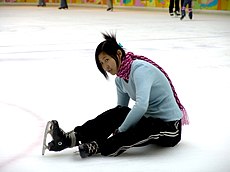User:Stephflores716
Epidemiology of Coccydynia
[edit]Pathophysiology of Coccydynia
[edit]Coccydynia, rather known as tailbone pain, has similar characteristics and can mimic those of sciatica, an infection, and/or fractured bones. It is important to recognize the symptoms, risk factors, and causes of this type of pain. Many would assume coccydynia is caused just by injury, but there are other factors that play a role in determining how this pain occurs. One of the most common risk factors of developing this pain is obesity. [1] The coccyx sustains the weight and pressure from above, therefore, having an abundance of weight determines the way someone sits down and can cause this area to become sensitive and painful. Other risk factors for this type of pain are those who are female, have osteoporosis, participate in contact sports, and who already have low back pain. Those with brittle bones and are active in contact sports such as cycling, rowing, and horseback riding are susceptible in developing coccydynia.

Causes of Coccydynia
[edit]One of the causes of coccydynia is childbirth. Two of the risk factors being female and extra weight, play a significant role in developing this pain. Postpartum coccydynia, a study done by Maigne, Rusakiewicz, and Diouf [2], showed that several women developed this pain as soon as they adopted the sitting position after delivery. This type of pain can also be caused by a traumatic fall or injury. A fall on the tailbone can inflame the ligaments and structure of the coccyx. Individuals do not have to be active to develop coccydynia, they may rather simply have poor posture. Poor posture puts pressure and stress on the coccyx area.
Prevalence of Coccydynia
[edit]This type of pain is can be very serious even though according to the ICD, coccydynia is rare, accounting for less than 1% of back pain conditions reported to physicians. This type of pain occurs five times more frequently in women than in men, with an onset around age 40. Coccydynia does not target a certain type of ethnicity or race.
- ^ Maigne, J. Y., F. Rusakiewicz, and M. Diouf. "Postpartum Coccydynia: A Case Series Study of 57 Women." 48.3 (2012): 387-92. PubMed. Web. Sept. 2012.
- ^ Maigne, J. Y., L. Doursounian, and G. Chatellier. "Causes and Mechanisms of Common Coccydynia: Role of Body Mass Index and Coccygeal Trauma." 25.23 (2000): n. pag. PubMed. Web. 1 Dec. 2000.
